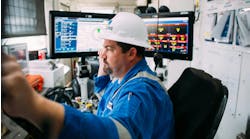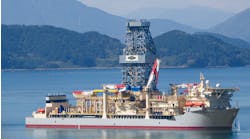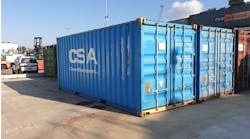Long-term contracts, preferred contractor status could even out drilling lows
Bob Rose, Chairman of the Board, President, and CEO of Global Marine Inc., and Sted Garber, President and CEO of Santa Fe International Corp., were interviewed following the announcement that drilling contractor Global Marine Inc. was commencing a merger with Santa Fe Inter-national Corp. to form the new company GlobalSantaFe Corp.
Offshore: What is the downside of the Global Marine/Santa Fe merger?
Rose: When people talk about the down side in merger transactions, what they really are talking about are the execution risks of putting two companies together. For GlobalSantaFe, the execution risks are minimal. Both companies have been pretty much steady state. As we've gone through due diligence and have gotten to know each other, we've found more similarities than differences in our two companies. We think the combination will go quite smoothly.
Garber: To investors, the downside is execution. We have a very, very good chance of success in our execution. We've already started planning the transition. If there is any other risk, it's that our employees get focused on the transaction as opposed to doing their work every day. We've talked to our employees both in the home office and on a worldwide basis. Globally, our supervisors and managers are very aware that their job is keeping people focused on the safe operation of our rigs and not worrying about this merger. We're doing everything we can to make sure that happens.
Offshore: Despite the many similarities, these two companies have very different views on spending. You've (Rose) been outspoken about the short-sightedness of building on spec, yet Santa Fe has several rigs being built without contracts in place. What will happen with these rigs?
Rose: There is no question that they (the rigs under construction) will go forward. And that was an issue that management and the directors of Global Marine considered quite carefully in this transaction. In looking at the construction program that Santa Fe has commenced, we became very comfortable with the type of rigs that are being built. They're building rigs that are really for niche markets - deep drilling jackups, ideally suited for the deeper horizons in the Gulf of Mexico (GOM), and ultra-deepwater semisubmersibles that will be aimed at the development and production phases of field development. These are just the kinds of rigs that we would want to build. With all the engineering that has been done and with the planning process they are going through with the shipyard, we became comfortable with Santa Fe's record for delivering their rigs on time and on budget.
Lastly, because this new company is going to be twice the size of either company before, we became very comfortable with our financial ability to fund this kind of spec building program. As we go forward as GlobalSantaFe, the board of that combined company will have a view as to whether to exercise the options Santa Fe negotiated (with very attractive prices), and that view will, of course, be considered in light of the prevailing market conditions at the time those options are exercisable.
Garber: The first of these options doesn't come up until the very end of 2002. By that time, we'll have a good sense of the user reaction to these rigs. So far, the comments we've had from our customers gives us a high level of confidence that we will have contracts in hand.
Offshore: How are you going to prepare your combined fleet to handle ultra-deepwater?
Garber: I think we're in an excellent position because that market is really evolving in terms of how it's going to be approached on a technical basis. The first round of building responded to an immediate need. The two new ultra-deepwater Global Marine drillships are excellent exploration tools for anywhere in the world. The two ultra-deepwater semis we're building are specifically designed as development tools. There are not many semis that have been designed to be development tools in deepwater, and we have discussed each customer's requirements as we entered into this program. While the combined ultra-deepwater fleet of GlobalSantaFe might be slightly smaller than our major competitors in deepwater, we'll have a very high quality, high-end fleet. And it's definitely something that we will have the opportunity to build on.
Offshore: How is the bigger fleet going to give you more flexibility?
Garber: It's really one of the key synergies of this merger. When we talk about flexibility, what we mean is the ability to serve users in any part of the world with any rig type. Global's main presence is the Gulf of Mexico, the North Sea, and West Africa. Santa Fe also has a strong presence in the North Sea, Southeast Asia, the Mediterranean, and the Middle East, but very little in West Africa, and nothing in the Gulf of Mexico. It is very difficult to move a rig to an area where you do not have an operation because there is no shore base.
One has to be established, which is difficult if one is not familiar with the local customs, the local labor, and all the local rules and regulations. A year and a half ago when the Gulf of Mexico was particularly strong, we might have considered moving one of our heavy-duty harsh-environment rigs to do deep gas drilling on the shelf, but we didn't do it because it would have required a single-rig operation. Now, if GlobalSantaFe wants to move a rig out of the Gulf, we have established operating bases in every key market in the world. We can go anywhere.
Offshore: How will consolidation impact the fleet?
Rose: The fleet will not change. There is perhaps one older unit in the Santa Fe fleet that might be sold as a result of this combination. Other than that, the fleet will remain as currently constituted, with the additional four newbuilds (two jackups and two semisubmersibles) scheduled to come later.
Offshore: As a larger company, how can you take some of the highs and lows out of the cycle of ups and downs that the oil and gas industry is subject to?
Rose: One of the ways is that we focus on the mega-majors and major oil companies as our primary customer base. These large companies are typically the companies that have the longer-term programs and larger projects available. Santa Fe has a tremendous amount of earnings already locked in. The combined company has 63% of total rig days during the next 12 months committed already. By dealing with those larger companies with the longer term programs, we can remove some of the volatility from the market place. At the same time, because of our exposure to the independents in the Gulf of Mexico, we're maintaining the upside when the natural gas market responds.
Garber: All of the majors, especially the super-majors, are considering different ways to contract for rigs. They have expressed an interest in forming long-term associations with a smaller number of drilling contractors. This means GlobalSantaFe could negotiate a long-term arrangement with Company X where the company already has the specs on every one of our rigs, and we maintain that for them electronically. Every time Company X goes to bid, it can avoid an extended pre-qualification process. Company X already knows the specs on everything in our fleet.
Secondly, we will have already worked out a broad contract so that we don't have to negotiate a new contract every time we want to work. With this combination, we will have the ability to say to any of the majors or supermajors, 'You can have a rig of any type virtually anywhere in the world under this long-term arrangement.' We will stand a much better chance of maintaining some stability and utilization on the downside. I don't think this kind of arrangement is necessarily going to increase pricing power. I do think it's going to create savings for both the customer and ourselves, which turns into better economics. And I also think that it will preserve our utilization and maintain it at a higher level than it would otherwise be on the down side. I'm not suggesting that this sort of an arrangement is in place, but we are in discussions with several of the super-majors.
Offshore: What are your plans for the next 6-12 months?
Rose: Job one is putting these two companies together in a way that is efficient and avoiding some of the problems that have befallen some of our peers that have gone through similar consolidations. Sted and I both believe that we have the plan that will enable us to put together these companies so that we can, from day one, efficiently and safely, run this company to the benefit of all our constituents: our shareholders, our employees, and our customers.
Garber: Since the end of last week (when the merger was announced) our focus has been explaining the new organization to our customers and making sure our customers understand the benefits this merger brings and the strength that it brings and making sure that our customers see this as a great opportunity for them.
Offshore: Now that you have more people, how will you solidify your personnel position?
Rose: First, having size alleviates part of the problem because we're able to draw from a much broader group. When we bring a new rig into the market place, we have a tremendous employee base to man that unit. Secondly, by becoming a leader in the industry, we will be the first place people want to work. This is going to be the company that someone who wants to start a career in this business will want to work for. Lastly, both companies have tremendous employee benefits. GlobalSantaFe will be a leader in benefit packages and safety programs, and we will find that people will gravitate to this entity.
Garber: Because of our financial strength, one of the things we'll strive for as the industry cycles up and down is to hold onto our critical skills. I can't envision a downturn given the overall personnel situation where we would not say to our critical skills people, 'You are going to stay here even if your rig isn't working now.' Our financial strength allows us to do that. Secondly, with the size we've got, we will be able to continue to support really good training programs and development programs and show people as they come into the company that there really is a career path here. That will enhance our ability to attract people and to retain people once they've come in.
Offshore: Will we see more drilling contractor mergers in the future?
Garber: I believe there will be additional consolidation at the top end, and we will see four or five 'super-size' drilling contractors. On the other hand, I believe there will continue to be a market for the good niche players. Several companies out there focus their equipment and expertise in very narrow areas, and they're good at what they do. I think these companies will continue to be successful. The guy in the middle, the guy who doesn't have a very strong niche, is less likely to survive.
GlobalSantaFe is going to have size at the premium end of the market. I don't think we would want to gain additional size at the low end. One of the things people ought to look for when they're looking at additional consolidation is what sort of fleets are being brought together. GlobalSantaFe aspires to premium equipment in deepwater and the high-end jackup markets. I think we're content to let others consolidate in other parts of the market.
With the strong financial position that this company has, both from a balance sheet standpoint and a cash-generating standpoint, we believe that GlobalSantaFe has an excellent platform for future growth. That growth could be internal growth through newbuilds. It could be external growth through acquisition of additional equipment, or possibly additional mergers. We'll have to look at opportunities as they come along. But I would emphasize that one of the strengths behind this merger, and certainly one of the objectives of both companies, is to build a strong platform for future growth so that we can continue to provide the kind of equipment desired by the market on a worldwide basis.





